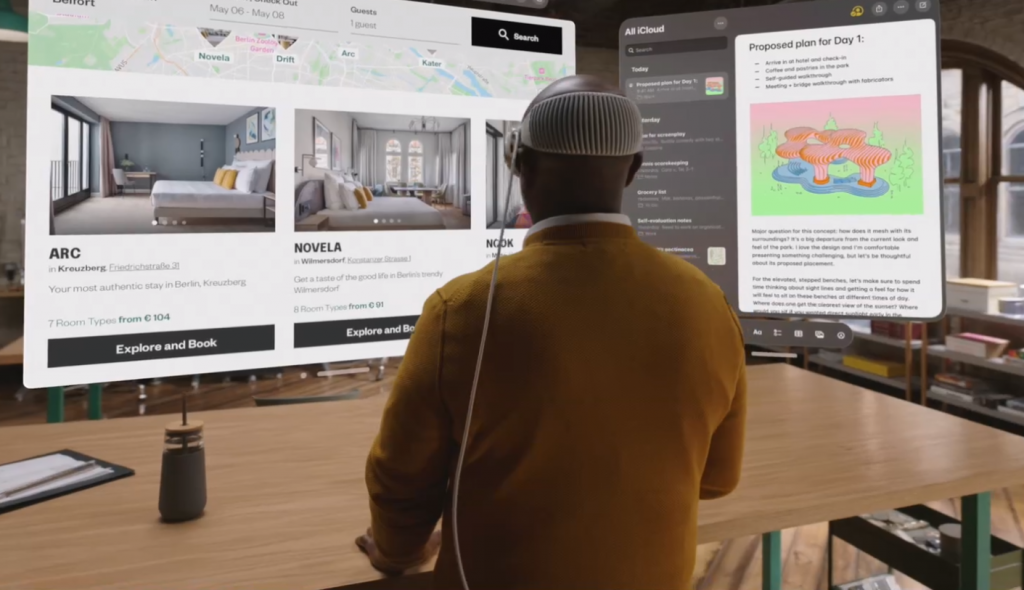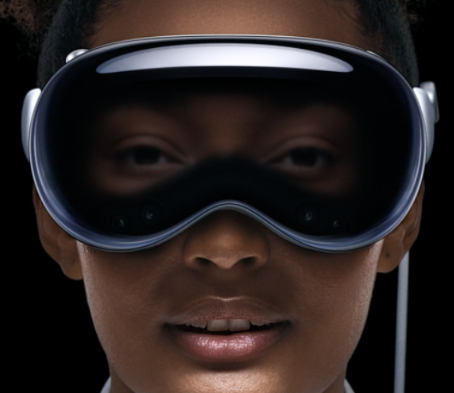There has been a hype train for over a year that Apple would release a VR/AR headset and now it has finally dropped.
From my early impressions I can say that apple have actually re-invented the concept of AR/VR. While other vendors have focused on 3D worlds, gaming and the m-word (metaverse). Apple have carved their own direction and it is a refreshing change.
Controllerless Design
As someone with Windows laptops and Android phone. There is no denying that Apple has always been the leader in input design. From the magic mouse, iPod dial and iPhone touchscreen. Apple have always made interacting with their devices as intuitive as possible. And the Vision Pro is no exception.
While other vendors have literally held-on to the concept that VR interactions needs controllers, Apple have freed the hands and allowed a combination of hand and eye tracking do the navigation. Personally I was like “Finally, Apple gets it!”. If you have ever used VR you will know that controllers are a cumbersome accessory and no matter how ergonomic they are they are always preventing your hands from being free. Meta have made impressive leaps with hand-tracking on their Quest 2 headset, but it is jarring to move between hand-tracking and then scrambling around for both controllers when needed.
With Apple’s device your interface is just the next version of the mouse. Your eyes are the cursor and your fingers are the click. Look, click, look, click. There is something beautiful in the simplicity and intuitive nature of this interaction that will not baffle non-gaming VR newcomers.
For interactions that need typing users are guiding down a speech-to-text route via Siri and for more productivity there is the ability to use a traditional Apple keyboard with the pass-through capability.
Eco-System (2D apps in 3D space)

Apples primary focus will always be their ecosystem and making sure current AppStore Content (mainly iPadOS) can be viewed and run within a virtual “compute Space” is at the heart of the Vision Pro. Regular 2D apps can now float in front and around you in your compute space.
Apple users will have a relatively seamless task of using the apps they are already familiar without relearning on day one.
Overtime apps will transition to encompass more Vision Pro features as more developers get there hands on these devices. But this will lead to a natural development by developers.
This slow transition will allow Apple users will be greeted by familiar apps as well as pure VR experiences.
“That crown goes to Varjo whom have been praised for their breakthroughs in this field”
AR/VR (2-Way Pass-through)
With current Augmented Reality in its technical infancy we are limited to how we can see out real world surroundings while immersed in a headset.
Passthrough was created to mimic this experience by placing cameras outside the headset to act as eyes to the world. This has evolved from grainy black & while imagery via IR cameras and is now at a stage where real objects are in full colour are details such as text are legible. Apple are not the first with full colour passthrough at high definition. That crown goes to Varjo whom have been praised for their breakthroughs in this field.
As Steve jobs once said “Good artists copy, Great artists steal”. Apple apparently used Varjo as a baseline for there own ambitious goals to achieve a high fidelity passthrough.
How this fairs in real life with sunlight bleeding in from open windows or dark rooms is anyone’s guess at this stage. We will have to wait another 6+ months before reviews start coming in.
Where Apple have been completely original is the concept of (as Marques Brownlee has coined) 2-way passthrough. Apple have incorporated an OLED screen on the outside of the headset. This is used to project a virtual representation of your eyes to the outside world giving an illusion that the headset is opaque.
There is no denying that this is a strange move by apple and one that could quite easily be passed off as gimmicky. However if you have ever used VR you will know that its main drawback is the isolating impact it presents to those around you. Apple are using this unique approach to bridge that gap between immersion and social awareness.
It works something like this. When the user is just seeing passthrough then their front of face (eyes and surrounding skin) are fully projected along with eye movements and blinks. The screen is also able to create an illusion of 3D imagery to the outsider through it’s array of sensors.

As a user becomes more immersed in their compute space the virtual face will start to transition with a soft animated graphic of swirling colours. When the user has dialled themselves into a fully immersed experience (via crown controller on headset). Then the swirling colours engulf the screen. Giving outsiders an indication as to how far down the VR rabbit hole the user is.
Time will tell if this works to bridge the gap between the immersed and everyone else, but I applaud Apple’s bold stance in trying something new.
Price – How Much!!!!!
I must finish this article off with a quick discussion of the price. This will realise in the new year for $3499 – I’ll let that sink in.
This is a rich persons toy aimed at app developers and early adopters. With the amount of tech that this headset includes I cannot say that this headset is overpriced and with no direct comparison from competitor it is in a league of its own.
As with all these devices Apple will be investing in this industry for a long time to come and the fact this version is labelled “Pro” would indicate that there may be a standard or SE version somewhere down the road.

Leave a Reply